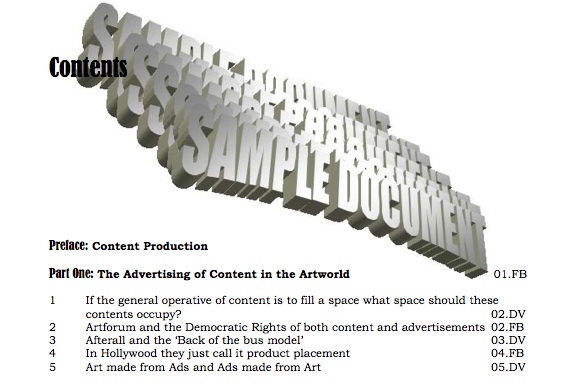This is an archive of the ArtCat Zine, 2007-2009. Please visit our new project, IDIOM.
PDF at Why + Wherefore

PDF
Curated by Summer Guthery, Lumi Tan, and Nicholas Weist
Various locations
19 July 2008
PDF, a group exhibition presented by Why + Wherefore and curated by Summer Guthery, Lumi Tan and Nicholas Weist opened simultaneously this month on 19 July across more than 20 international venues. The exhibition was a reproducible selection of specially commissioned PDF files authored by the invited artists. It was installed at each of its material sites for a single day only, while the PDF files constituting the show remain freely available on Why + Wherefore's website, along with instructions for producing a material exhibition of the work. Adobe's 15 year old Portable Document Format is the successor to several alternative page description formats - like the more print-oriented Postscript (also developed by Adobe) - and has been popularized in the distribution of technical literature, business documents, electronically published texts, and artist portfolios. PDF likewise plays across this technology's many popular uses, with contributions including Fia Backström and Danna Vajda's engaging dialog on the meaning of content and the production of meaning, Bozidar Brazda's single-page concrete poem, Jordan Wolfson's book-length collage of found and original images and texts, Paul Ramirez Jonas' ascii drawing, Rachel Mason's playbill for a morbid re-imagining of the trial of a fallen dictator, Brian Clifton's serial memorial to the known victims of the Tiananmen Square Massacre, Sean Raspet's cryptic assemblage, and an arbitrary selection from Dexter Sinister's library.
With the totality of the show in view, it becomes clear that PDF's curators may well be more interested in the exhibition's structural concept - and its overt provocation - of an infinitely reproducible cultural product rather than the individual works exhibited or their particular harmonies and dissonances. And why not? That such a provocation is outside the legislating and deeply managed techno-optimism of a Creative Commons or similar framework lends clout to both the artists and curators involved, who put culture before ordering principles. What the three young curators are here proposing, among other things, is a traveling exhibition whose own contemporaneity threatens to disrupts the particular form from which it originates and propagates: the form of the art exhibition. That this exhausted form is placed so explicitly at the service of a text, or series of texts, could well point to the institutional struggles over the exhibition catalog, contested grounds for curatorial autonomy and power. But there's something more interesting happening here as well: the exhibition as a form actually functions like a kind of modest on-ramp for the works commissioned, to emerge from or return to what artist Seth Price might call a popular archive. It's not so much that the traces, texts, files, documentation, and various installations of PDF make up a narrative of origin and consequence, but rather a constellation of parts in ambiguous relation to one another.
ZINE
HOME
TIPS / COMMENTS
CATEGORIES
CONTRIBUTORS
- Greg Afinogenov
- B. Blagojevic
- Adda Birnir
- Susannah Edelbaum
- Julie Fishkin
- Paddy Johnson
- Jessica Loudis
- Christopher Reiger
- Andrew Robinson
- Peter J. Russo
- Blythe Sheldon
- S.C.Squibb
- Hrag Vartanian
